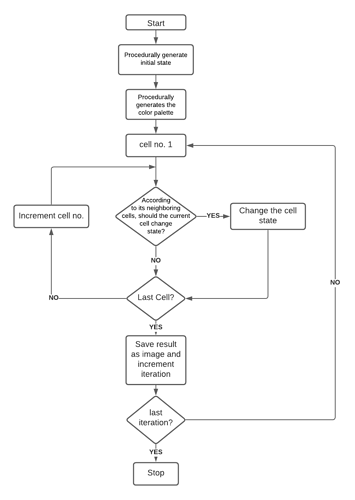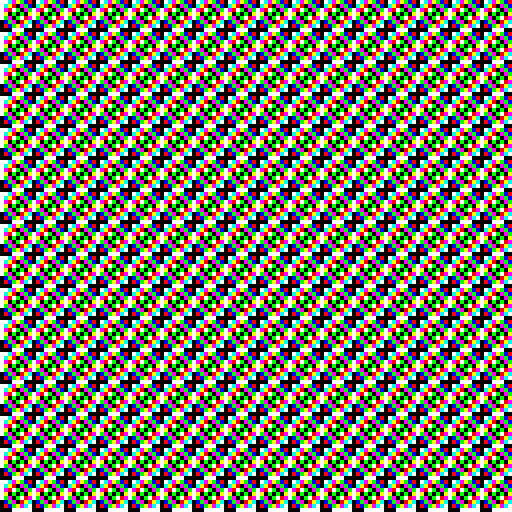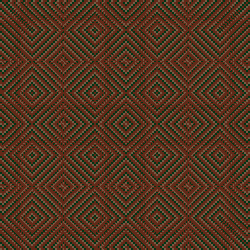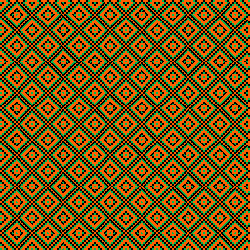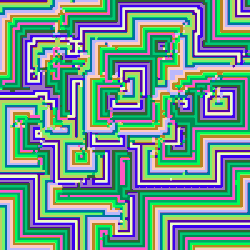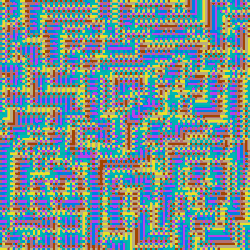Funding Tier: Tier 1 - $1000. New to NFTs, New to Art. Looking to explore new ideas.
- Project Overview:
-
Project title and description.
- Project Title: Engenhoca Arteira.
- Project Description: Engenhoca Arteira is a collection of abstract animations created with computer algorithms. In Brazilian Portuguese, the title refers to a machine that makes art. In this way, cellular-automaton and procedural generation algorithms will be used in order to create images using the game engine Unity 3D. Later, these images will be used in video-editing programs to develop animations.
-
Why are you interested in creating this project and or collection?
- I am a game developer and passionate about mathematics, programming and art. In the last few months, I have learned a lot about generative art and I believe that this is a unique opportunity to initiate my artistic career, learn about NFTs and try new ideas of generative art. As a user of the Conflux, I am interested in helping the project to promote the ecosystem. I hope my art brings new users to the Conflux.
- Project Details:
- High level conceptual approach:
Initially, the Engenhoca Arteira collection will have 30 abstract animations, in GIF animated format, that will be generated by computer algorithms. Cellular automaton bi-dimensional and procedural algorithms will be used to build images in Unity 3D. Then, the images will be used in video-editing programs to create animations.
A bi-dimensional cellular automaton consists in a cellular grid where each grid has a finite number of states and, over time, cells change those states according to some rules. A cellular grid when time is zero is called initial state (time t=0). For example, in figure 1 we have an initial state of the bi-dimensional cellular automaton with two states, with white and black cells that represent dead and alive cells, respectively.

Figure 1 – Initial state of a cellular automaton with two states (alive and dead cells)
All cells around a cell are called neighborhood. As time passes by (growing t+1), a new generation of cells are created from their own states and the state of its neighbors. Figure 2 shows the result of a cellular automaton called Game of Life.

Figure 2 – Cellular automaton Game of Life with two states.
In order to create the images, first it is necessary to set the cellular automaton, choosing a number of states and the colors which will represent them, defining their rules and setting the initial state of the cell grid. This configuration can be done by procedural algorithms or manually.
When the automaton starts, all new generations are saved as images and, after some iterations, the procedure ends, and those images will be used in video editors to create GIFs. A flowchart of the image creation by the automaton is described in figure 3.
Figure 3 – Flowchart of the creation of images by the cellular automaton.
Figure 4 illustrates the initial state of a cellular automaton with eight states, each one represented by a color (state zero is white, one is black, two is red, three is blue, four is green, five is yellow, six is pink and seven is light blue). In each subsequent generation, if a cell has a neighbor cell which state is its successor, the cell is consumed and assumes the next state. Figure 5 shows the result of the automaton at the end of some generations.
Figures 4 and 5 – Initial state and generated art by a cellular automaton of 8 states.
- Any design mockups or sketches

Figures 6, 7, 8, 9, 10 and 11 - Examples of some experiments with cellular automatons.
-
Overview of the mediums being used:
- Generative art
- Algorithm Art
-
Your collection themes and thesis:
- Collection theme: Art generated by computer algorithms.
- Thesis: Cellular automation combined with procedural generation of contents makes possible the creation of a multitude of artistic works, each one with unique features.
- Team:
-
Name of team members, and their roles and responsibilities:
-
Isaac Lopes: Artist and Programmer. Responsible for the algorithm creation and artistic collection disclosure).
- He has a wide experience with software and game development. He is also trying new ideas and still learning about generative art and NFTs.
-
Isaac Lopes: Artist and Programmer. Responsible for the algorithm creation and artistic collection disclosure).
-
Team members’ emails and social media handles:
-
Team’s relevant experience:
-
Isaac Lopes is a Frontend Developer at Bitfy, Founding Partner and Head of Technology at Mad Pixel Studios. He holds a Bachelor’s degree in Computer Science from the University of Brasilia, with more than 7 years of experience in developing mobile, web applications and games.
At Mad Pixel Studios, he worked on more than 50 projects, managing the team and programming. He has experience with various technologies, programming languages and infrastructure.- Frontend technologies: ReactJS, Angular, React Native, Redux, Axios;
- Backend technologies: NodeJS, Spring Boot and .NET;
- Database Technologies: MongoDB, SQL, PostgreSQL and Oracle;
- Game technologies: Unity3D, Monogame, ThreeJS, OpenGL, SDL2;
- Augmented Reality Technologies: Vuforia, Leap Motion;
- Programming Languages: C#, Typescript, Javascript, ES6, C++, Java, Mips Assembly, Python;
-
Isaac Lopes is a Frontend Developer at Bitfy, Founding Partner and Head of Technology at Mad Pixel Studios. He holds a Bachelor’s degree in Computer Science from the University of Brasilia, with more than 7 years of experience in developing mobile, web applications and games.
-
Links to any previous work / portfolios:
- Portfolio as Game Dev: https://madpixel.com.br/#section-games
- Interview as Game Dev: https://thegdwc.com/blog/blog.php?blog_id=36
-
Grant Milestones:
- Total Grant Budget: $1,000
-
Total Timeline: 6 weeks
-
Milestone 1 (1 week): Social media and landing page for the collection
- Budget: $200
- Deliverable 1: Create a social media for the collection.
- Deliverable 2: Create a Discord channel for the future community.
- Deliverable 3: Create a landing page for the collection.
-
Milestone 2 (1 week): Algorithm improvement and generation of the first works.
- Budget: $300
- Deliverable 1: Implement new algorithms for color palette generation and new algorithms for the generation of new states.
- Deliverable 2: Implement new rules for the cellular automaton.
- Deliverable 3: Create and mint the first 5 works for the collection.
-
Milestone 3 (4 week): Creation, disclosure of the collection and community engagement.
- Budget: $500
- Deliverable 1: Create and mint 25 more works for the collection.
- Deliverable 2: Post the works in social media, website and Discord channel.
- Deliverable 3: Release the NFTs in marketplaces.
- Deliverable 4: Focus on engagement actions and the community.
-
Milestone 1 (1 week): Social media and landing page for the collection
-
Community Engagement:
- Social media: posts about the project development, work disclosure, News and announcements in Twitter, Instagram and Discord at least 3 times a week and disclosure of artistic works from the collection in the landing page.
- Community engagement actions: collect feedback from the community and provide discussion on interesting new ideas using forms. Weekly prize draws of NFTs to increase the interaction and growth of the community.
- Marketing Conflux Network: the greatest challenge of the Engenhoca Arteira collection will be attracting people to a developing platform, such as Conflux web. It will be necessary the help of Conflux Network in our marketing strategy in order to disseminate the artistic works and include them at the actual marketplaces of Conflux.
-
Long Term Vision:
-
What is the long term vision of your work, and how will it help support the mission of Conflux to enable creators, communities, and markets to connect across borders and protocols
- Disclose the own Conflux ecosystem: it is expected that the collection Engenhoca Arteira will become recognized and renamed. It is also expected to attract new people to be Conflux users.
- Try new ideas: it is expected that this work will continue after the Conflux period of residence, with experimentation of new algorithms and the increase of new artistic works for the collection.

